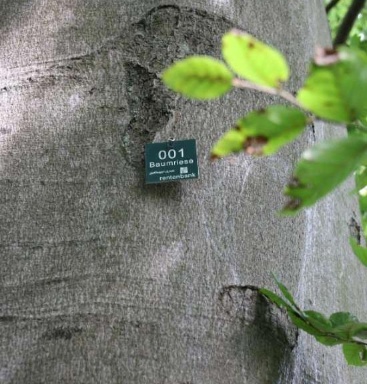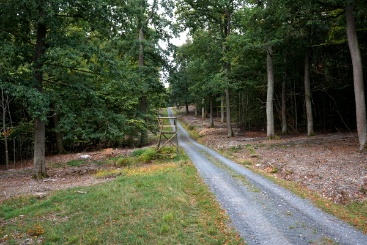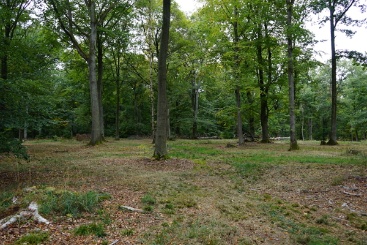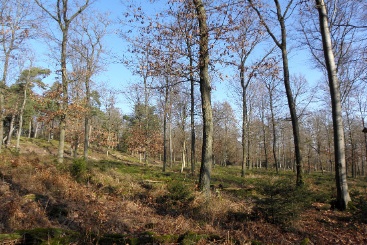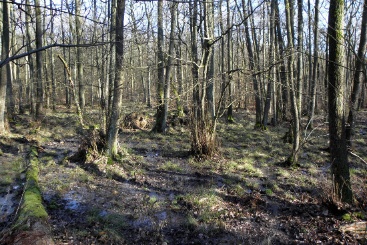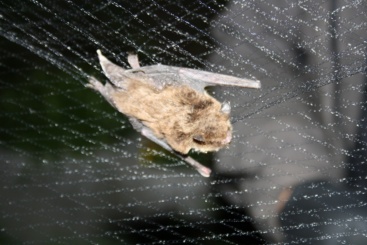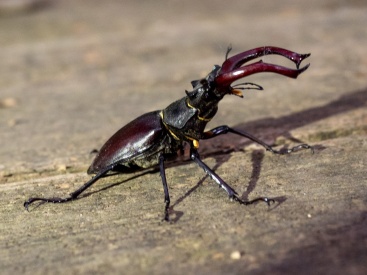Sustainable Silviculture
Rentenbank and the Institute for Federal Real Estate Bundesanstalt für Immobilienaufgaben (BImA) have concluded a framework agreement on the long-term ecological cultivation of 550 hectares of forest in the region of Wetterau in Hesse. The BImA manages the forest and organizes additional projects within this framework agreement which contribute to nature conservation.
The 1,000 giant trees projectImproving habitats and conserving species
The 1,000 giant trees project constitutes a core project as part of a framework contract between the Federal Forestry Office (Bundesforst) and Rentenbank. The mixed deciduous and coniferous forest at Winterstein in the region of Wetterau in the state of Hesse presents an ideal starting point, as it is characterized by a large proportion of mature trees.
The aim of the project is to secure specific trees which are important for nature and species conservation. To this end mature, large trees which are full of life are removed from the timber business so they can rejuvenate the forest naturally through their seed scattering. In addition, some branches die as part of the trees’ aging process. They provide valuable cavities and shelter for species which may now no longer be native to the cultivated forests. Protecting the giant trees has meant that we have improved the habitat for rare species and stabilized their populations. To identify the giant trees at any time, we localized them by GPS and attached environmentally-friendly plaques to them (see photo).
The Grimmelschneise projectForest edges create important habitats
Due to the way they are shaped, forest edges have a very high value from a nature conservation perspective. The change from light to shade and the impact of the transition from tree to shrub and herb layers create ecological nooks and crannies for specialized animal and plant species.
The special compositions and temperatures within the forest edges provide optimal living conditions for insects which are the main source of food for many types of bats and birds. Forest edges therefore constitute a typical hunting ground for bats and birds.
The Grimmelschneise project aims to optimize feeding and hunting ground for bats and birds by creating better living conditions for insects. We initiated a package of measures from initial preparation to maintenance measures to support the project.
Actively preparing the cleared areas and removing shade-giving individual trees sheds increased light on the flora and fauna around the paths and means that flowering plants can thrive and numerous insects can settle there as well. In addition, flowering shrubs are planted and grass seed and herb mixtures are sown along the edges of the paths. The aim is to create a meadow from spring until summer for bees, butterflies and other insects.
Amphibians and reptiles are also supported by this project which is financed by Rentenbank. To this end, we created wetlands and rocky habitats where the animals like to live.
The Caspar David Friedrich forest projectProtecting biodiversity in the warmer forest soil
Images with a mixture of healthy individual trees, timber from trees which are dying and numerous clearings or ’silvopastures’ are best known from the paintings of Caspar David Friedrich (1774-1840) but a rarity in today’s standard commercialized forests.
An expert in nature conservation might say that, due to their sparsity, silvopastures do however provide shelter for rare animal and plant species which require the light and warmth that dark forests do not offer. The Caspar David Friedrich Forest project aims to emulate a regular grazing of the forest using periodic measures paying special attention to light conditions in the forest and in the soil.
A large number of species of insects and butterflies which like warmth benefit from the warmer forest climate with patches of light. They, in turn, provide the main food source for many species of birds and bats. Various types of plants also thrive in sparse forests. This includes protected species (e.g. liverwort, snowdrops and hedge violets), which have become rarer in our forests which are mostly dark.
The measures supported by Rentenbank should specifically prevent the emergence of a dense canopy allowing enough light to reach the forest floor. Furthermore, providing dead wood and rocky habitats will create additional habitats for beetles which live in wood, reptiles, birds and bats.
On silent pawsMonitoring an animal species which is greatly endangered
You won’t spot it but the European wild cat lives in Germany’s forests. Throughout the country as a whole and specifically in the state of Hesse, this species is highly endangered (on the watch list for Germany and Hesse). Several of these shy creatures have been spotted in the mountains and forested areas of the Taunus range, north of Frankfurt. The wild cats love forests which are structurally diverse and in harmony with nature because they can seclude and conceal themselves. At night they hunt. Their diet primarily consists of mice but also rabbits, lizards, frogs, insects and small birds.
The Buchenborn forest offers wild cats ideal conditions. It is managed in a way which is in harmony with nature and which creates pockets of light (see the Caspar David Friedrich Forest project, Grimmelschneise Project and Sommerhang). The area includes deciduous and coniferous trees, as well as denser younger forests and open areas, which can be used as hunting habitats. The vast, uninterrupted forest provides them with the quiet and space they need to choose an area for breeding and remaining out of sight.
The wildcat population across the whole Buchenborn estate is recorded and charted through support from Rentenbank’s ‘On silent paws’ project. Observation cameras are set up alongside poles with brushes which are regularly infused with the plant Valerian to lure them from the beginning of January until the end of March. The Senckenberg Research Institute based in Frankfurt carries out the genetic analysis of the hair samples which are caught in the brushes.
SommerhangAn oak forest bathed in light as a habitat for wild cats
Open and half-open forest structures are relicts of historical forest usage and seldom to be found in Germany. It is supposed that silviculture in the Buchenborn estate dates back to the construction of the Limes Germanicus (the fortified frontier between the Roman Empire and the unsubdued Germanic tribes).
Sommerhang forms part of the Buchenborn Forest estate. It was probably managed as a coppiced forest. Tree species such as oak, lime, poplar and hornbeam which are capable of stump-shooting (coppicing) grew here. While stump shoots were regularly used for firewood in the past, the more established shoots with single trunks are now left. They were intended to grow tall and rejuvenate the forest on a regular basis.
From a certain size, the trees were used for high-value wood varieties such as construction timber. In addition, the oak forest could be used for fattening of livestock in the autumn. As the age of the tree population has increased, coppicing has reduced which has ultimately resulted in forests which are less dense. More light now reaches the forest floor due to the trees which are placed fairly far apart. This creates a warm and dry forest climate. A variety of rare animal and plant species find an ideal habitat here. Wild cats also prefer these warm, sunny spaces.
The oak forest which is suffused with light in Sommerhang has been completely maintained or newly established in part thanks to the sponsoring of the project. To this end, new oaks are being planted and the spruce, pine, larch and beech saplings are constantly removed. Habitats specifically for mammals and birds are put in. For instance, this includes dead wood lying around because it provides the wild cat with shelter for hunting and rearing its young. Nesting aids for numerous species of birds and bats count among these measures.
Wet FeetPrecious room for plants and animals to live in
Forest mires are always wet and permanently flooded - the base of the tree trunks is constantly in water i.e. the trees always have 'wet feet'. This is due to a constant high level of ground water with a fluctuation of less than a metre over the course of a year. Such forests actually tend to be flooded in spring.
An alder forest mire is being established in one part of the Buchenborn Forest area through support from this project. Initially, a drainage ditch, which was laid here in the 1970s, was closed to encourage the natural rewetting of an alder forest mire over an area of 1.6 ha. The indigenous species of alder can cope very well with a great deal of rewetting and fluctuating water levels.
In addition, wet hollows were installed so that water holes and puddles can emerge. They provide the numerous insects and amphibians with a habitat and breeding ground. The plant diversity in the ‘undergrowth’ (herbaceous layer) should also increase. Plants which love humidity such as sedges, ferns and forest moss, bittersweet (nightshade), gravel root or wild calla (calla palustris) tend to be found here.
Dracula’s larderConservation and protection of indigenous species of bat
All known species of bat in Germany are critically endangered (on Germany’s red list). Nocturnal animals spent their days in the hollows and splits of trees which they leave at dusk to hunt for insects. Deciduous forests which are old and full of hollows provide bats with these ideal conditions.
Saplings are specifically obtained from mature beech forests over a surface area of 0.8 hectares in order to improve the habitats of indigenous species of bat such as the greater mouse-eared or barbastelle bat. This makes the forest less dense.
The availability of hollows and splits increases for bats as the trees mature. The amount of deadwood also increases and this provides numerous insects for the bats to feed on with a habitat. As bats often change their roosts to counter infestations from parasites and escape from predators, bat boxes are also being installed.
Insects’ StagNew habitat for the stag beetle
The stag beetle is Europe’s largest species of beetle. It is on Germany’s red list and is critically endangered. Male stag beetles can grow to up to 10 cm in size. They have distinctive mandibles (mouthparts) which resemble the antlers of stags. The females have much smaller mandibles and grow to between 3 and 5 cm long.
The stag beetle spends most of its life underground in rotting stumps of wood as larvae (5 to 8 years). It feeds on rotten and damp wood there. The stag beetle favours mature and open oak forests in dry south-facing areas. They tend not to choose other deciduous trees such as beech, ash or elm trees. A lot of standing and fallen deadwood is important to them. The stag beetle needs old rootstalks from a diameter of 40 cm to lay its eggs and for the larvae to develop.
It only lives for around 8 weeks as a beetle when it focuses on mating. This is when the male uses its ‘antlers’ to fend off its rivals to win the favour of the female.
Stocks of deadwood are maintained and also augmented over a surface area of one hectare where many oak trees are over 180 years old. In order to create the best conditions for eggs to be laid and larvae to develop, ‘stag beetle cradles’ are being installed, i.e. buried, rotten oak logs, in which the beetle can lay its eggs.
